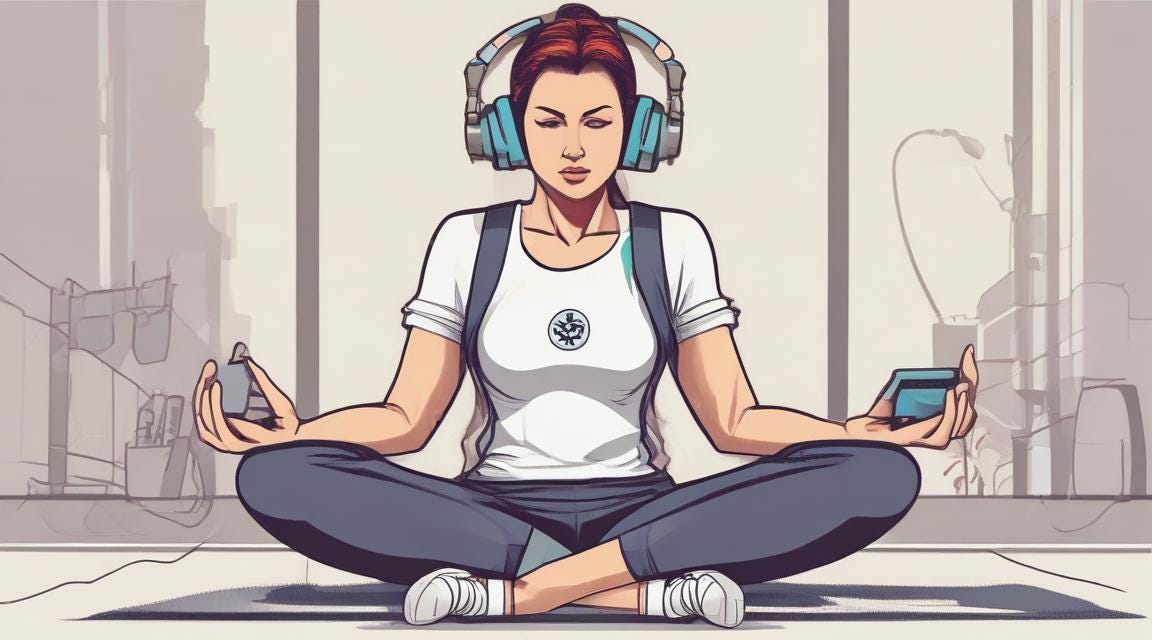The multitasking meditator: The addiction design strategies behind mobile mindfulness apps
When people use their smartphones to access guided meditations on apps engineered to distract them, it is unlikely that they will experience benefits relative to mood or attention.
Last year, the mobile meditation app industry was expected to earn close to $1 billion in U.S. sales, doubling annual revenue from before the pandemic.
Yet as the author of a recent study concludes, when people use their smartphones to access guided meditations on apps engineered to distract them, it is unlikely that they will experience benefits relative to mood or attention.
Instead, users may simply be substituting one form of carefully designed addiction for another — reinterpreting their “experiences as mindful, even when digital platforms ironically lure them into practices that are distracted and compulsive,” writes the study’s author Rebecca Jablonsky.
The growing popularity of meditation apps “signals the expanding power of behavioral design, which not only changes how people behave but changes how people think and feel about their behavior.”
Merchants of distraction
Over an eighteen month period, Jablonsky attended several U.S. and Canadian tech industry events, conferences, and meetings. She also interviewed seventeen meditation app company managers and designers; visited the headquarters of two leading app makers; and interviewed twenty-one meditation app users.
Ethnographers like Jablonsky combine close observation of organizational settings, document analysis, and open-ended interviews to arrive at richly detailed accounts of human behavior. The downside to ethnography is that a study may lack broader generalizability across a population — meaning that studies using a diversity of other methods are needed to build stronger confidence about an initial set of findings.
Many in the mindfulness app industry, as Jablonksy reports, believe they are “channeling the addictive properties of digital technology toward a healthier form of attention that could restore for users a sense of agency, control, and even personal meaning.”
In doing so, they are making a bold promise that using their app will “somehow reduce or reverse the negative mental effects of other popular contemporary digital technologies.”
When an app company lures new users by way of a carefully targeted social media campaign, the typical offer is free access to a sample video or audio meditation designed to elicit a positive emotion.
“Meditation app companies thus capitalize on their knowledge that potential users are already anxious — they are in some form of pain that needs relief — and use this to their advantage by making the first experience of meditation pleasurable and easy,” notes Jablonsky.
Among mobile meditation companies, Headspace spends the most on media advertising, sometimes in collaboration with other brands.
As part of the “Food for Mood” campaign, Headspace partnered with Whole Foods to offer free guided meditations promoting “Joyful shopping,” “Cooking with gratitude” and “Mindful eating.”
In another example, Headspace in September 2021 launched a YouTube ad campaign intended to target users across countries. The ad suggests that the global pandemic is on the wane. Images feature actors wrestling with their children, floating on their backs in the ocean, hugging elderly relatives, and staring into the eyes of babies.
Testimonials from users read by actors declare how much meditation has helped them: “This year has been stressful, but then I found Headspace.”

Once an individual downloads a meditation app like Headspace, the app sends a constant stream of notifications intended to promote greater frequency of use and more downloads — which generates more revenue for the company.
“The attention designed into meditation apps thus is not the mindful attention that is promised, but rather reflects forms of attention considered more valuable and profitable to the broader technology industry — an attention that is malleable, compulsive, and distracted,” writes Jablonsky.
Technological antidote
In one interview, a meditation app company executive described their typical user as looking to escape the “fundamental conditions of modern life,” an existence which involves millions of demands on their attention.
Examples include “people going to bed feeling upset with themselves because of their friend’s Instagram accounts,” or someone who “can’t focus their way through a conversation with their partner because their Apple watch keeps buzzing.”
According to the executive, meditation apps were the “technological antidote to the problems that technology has created.”
In a second interview, a former design director at Muse — maker of a “brain sensing” meditation headband — described his work as a form of “attention activism.”
Meditation apps are “about exercising your right to decide what to pay attention to. It’s about resisting those who want to profit from selling something that belongs to you,” he said.
According to its Amazon page, Muse’s brain sensing headband enables users to discover their “mind-body connection through powerful, accurate real-time feedback on brain activity.”

The device is supposedly able to notify a user if they have a “busy mind” (signaled by way of “stormy weather” noises) or a “calm” mind (“peaceful weather” noises).
The gamification strategy promotes frequent headband use by rewarding users with diamond-shaped “Muse points” and bird-themed milestones. “Is this what happens when Angry Birds get therapy? It’s fun, but should it be?” writes The Guardian’s Rhik Samadder.
Binging on mindfulness
Among the twenty-one meditation app users that Jablonsky interviewed, a majority “regularly described their broader technology use habits as through the lens of popular critiques of technology ‘addiction,’ while turning a blind eye to their compulsive use of meditation apps,” she writes.
Several users blamed themselves (rather than the app) when their efforts at meditation did not seem to work, concluding that “they needed to be more mindful and pay more attention — reinforcing the value of the meditation app circularly.”
One said that using Headspace was similar to her “binge-watching” television habits. She purchased a thirty-pack of meditations, binged them quickly, tried to meditate on her own once a week, and then stopped. If she tried a meditation app again, she expected to repeat the cycle of binging and purging.
Another user knew that his Calm meditation app was not as beneficial as an in-person meditation class, but it was the only option he could fit into his hectic work schedule.
“His use of meditation apps thus remains palliative, providing a temporary fix that is interchangeable with other fixes,” writes Jablonsky. “He doesn’t expect to achieve a state of mindful attention from the meditation app — he simply expects to feel better in the moment.”
A third user described using her Headspace meditation app like a podcast, listening to the calming voice of Headspace founder Andy Puddicombe (a former Buddhist monk) while doing chores and writing emails.
“The meditation app doesn’t absorb her full attention but simply reminds her of the things she would like to pay more attention to when she has the time — notably her own self-care,” writes Jablonsky. But this also leaves her stuck in “a state of distraction from which she must recover continuously through efforts to pay attention.”
However, some interviewees were aware of the traps involved in using mediation apps, optimistically believing that they could exert control over them.
One said she typically used the timer on her device as part of self-guided meditations that she would do in a quiet room. She believed she was taking advantage of the “better tool, which is the real mindfulness — either focusing on your breath or paying attention to your thoughts.”
A second user had spent years studying meditation in his native India. He described meditation as “building a muscle” and attention as a form of discernment. His experience allowed him to know when he needed to use an app versus something else and says he uses an app to meditate twice a day for 30 minutes.
The quest to design an app that facilitates mindful attention is “impossible to fulfill as the affordances of the smartphone and its suite of digital tools capture attention in equal — if not greater — measure as meditation apps claim to give it back,” concludes Jablonsky.
Addicted to distraction
Even when we try to use smartphone apps minimally and mindfully, we run up against an impossible task. Meditation app companies have joined Facebook and other social media platforms in recruiting some of the world's brightest minds to create an unbeatable chess game.
In using any of these apps, we are battling artificial intelligence and algorithms with almost perfect information about us — machine learning tools that aim to keep us addicted to distraction.
It is not just smartphones and apps but online immersion itself that is the death of our focus and attention. “As our window onto the world, and onto ourselves, a popular medium molds what we see and how we see it — and eventually, if we use it enough, it changes who we are, as individuals and society,” wrote Nicholas Carr in 2011’s The Shallows: What the Internet is Doing to Our Brains.
RELATED: The Moderate-Minded Writer
He argued that replacing printed books and articles with screen-based text, images, and video marked the transition between two dramatically different modes of thinking.
When printed books and articles were at the center of human culture — the linear medium cultivated habits of mind related to concentration and disciplined thought.
“As supple as it is subtle,” the book has been “the imaginative mind of the Enlightenment, the inventive mind of the Industrial Revolution, even the subversive mind of Modernism,” wrote Carr.
In contrast to the book, the Internet incentivized a reliance on skimming, multi-tasking, superficial thinking, and short-term memory rather than deeper understanding.
Over time, as the mental circuits devoted to constant online multitasking strengthen, the circuits used for reading and concentration erode. The altered brain consequently finds it more difficult to concentrate and read deeply — as numerous studies in subsequent years have shown.
When the tenth-anniversary edition of The Shallows was published in 2020, Carr, in an updated introduction, built on his thesis that digital technologies continued to make people more distracted and less focused.
The diffusion of smartphones has accelerated this process. “It’s common today, even more so than ten years ago, to think of knowledge as something that surrounds us, something we swim through to consume, like sea creatures in plankton-filled waters,” he wrote.
Delete your apps
If you aim to improve your attention and mental health, instead of relying on a meditation app, you are better off ridding yourself of the full suite of addictive technologies that distract you.
Start by deleting almost every app on your phone and tablet that is not a GPS or map; turn off all notifications; silence your text messages; cancel your streaming services; and hide your devices in an inconvenient location for twelve hours a day [start after dinner], and ideally a full day on weekends.
After taking these steps, you can start to rebuild your attention and boost your mood through various embodied practices and activities.
You can rediscover the joy of books and the tactile feel as you turn the pages; spend time writing every day in a well-crafted journal using a specially chosen pen or pencil; draw and color in a sketch pad; clean, build, and fix things around your house; cook your meals [with no music or podcasts]; take a walk in a park [with no headphones]; or attend a regular yoga class at a neighborhood studio.
If you are interested in meditation, make the time to connect with a local Buddhist meditation group [which is usually free and open to all]. There, you will find experienced teachers to guide you, an ethical philosophy, books and readings to help you make sense of life, and a community of people to share the experience with.




